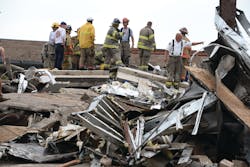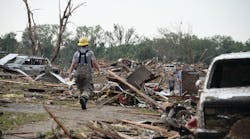May 20, 2013, is a date many Oklahomans will remember for a long time. While responders in central Oklahoma were gearing up for what would be the third major tornado to hit sections of Moore and south Oklahoma City, many first responders were still cleaning the storm debris off of their gear from tornadoes that hit portions of Edmond, Shawnee and several other communities the day before.
When the storm sirens sounded that Monday afternoon, federal, state and volunteer organizations from all over the nation were already in Oklahoma or enroute to help manage the response to the massive storm outbreaks the day before. The swarm of major storms that swept through suburban areas around Oklahoma City provided distinct challenges to area response officials. The Moore disaster in particular provides examples of how large-scale disasters can be managed effectively and offers valuable lessons for other communities.
Since its inception, the Federal Emergency Management Agency (FEMA) has funded jurisdictions all over Oklahoma and the Midwest with millions upon millions of dollars in homeland security preparedness grants to increase awareness and readiness against terrorist events that were expected to occur after 9/11. But terrorist threats aside, one certainty is that every year, somewhere in Oklahoma an urban, suburban or rural community will come face-to-face with the incredibly destructive forces of a severe storm. That was the case May 19 and 20, 2013.
Many of the incident commanders operating during and after the storms shared strikingly similar challenges and are sharing the lessons learned in how to better prepare for managing large-scale weather-related incidents. The destructive lightning, flooding rains, multiple tornado outbreaks and hail as big as softballs (that Oklahomans must deal with each year), challenge those in the emergency response community to look closer at disaster-management skills and readiness plans for major storms.
“Weather aware mode”
Oklahoma has some of the best weather forecasters in the nation. Every year, thousands of Oklahomans stake their lives and property on the accuracy of their predictions. A popular “tag line” used by a local TV station in the Oklahoma City is “be weather aware,” which indicates that a certain weather pattern will likely cause major storms to “fire up” in a particular area. One advantage of early forecasting (often as long as 24 hours in advance) is that it gives emergency managers and response officials time to prepare for the possibility of a major storm. This “calm before the storm” is the time when local emergency managers and their staffs are at their busiest, but emergency response officials now understand the important of several specific preparedness activities.
First, when the possibility of a tornado is in the forecast, consult emergency operations plans specific to tornadoes. During the “weather aware mode,” a well-developed Emergency Operations Plan (EOP) will address many of these issues and provides resources, contacts and solutions on how to effectively manage the situation. Review the section marked “Tornado” and become refreshed on what the community’s general plans are for managing a severe storm. While each storm will present unique challenges, emergency responders will face search operations, infrastructure and power failures, multiple injuries, triage, treatment, sheltering displaced individuals and perhaps thousands of volunteers and truckloads of donations to manage in the hours and days after a storm.
A suggestion identified in after-action meetings is for emergency response administrators to contact staff-level officers and, if necessary, review local policies and procedures regarding weather-related incidents. When possible, include specific information outlined by the community’s EOP. This will help keep staff-level officers mindful of the “big picture,” particularly when command must prevent front-line responders from focusing on the first person who flags them down after a storm. Often, individual first responders stop to care for the first injured person who flags them down without realizing that higher-priority needs are just around the corner.
Second, it is helpful if station and line supervisors ensure that personnel are “brushed up” on the local wide-area search procedures, standard search markings and personal protective equipment (PPE) requirements appropriate for their districts. Search and rescue supplies that are not normally kept on first-response vehicles (i.e., spray paint, search equipment, triage equipment and specialized clothing) should be distributed to stations or, at minimum, adequate supplies kept on hand in command vehicles.
Third, if your jurisdiction is not already holding jurisdiction-wide preparedness meetings, a telephone call should be made to the other emergency disciplines in the community, and possibly to mutual aid response partners, to discuss general considerations and/or locations for a unified command post, staging area, evacuee shelter and reunification area in the event of a widespread disaster. Even though it is possible that an alternate site for these areas may have to be identified after the storm hits, discussing command post needs (such as power and water supplies) in advance can help speed the process for identifying a final workable solution. Even though an organization has access to a mobile command post, that should not eliminate a discussion of the possible use of a fixed facility. This may be the preferred option, since Type I incidents of national significance cannot be efficiently managed by using strictly mobile command vehicles.
Fourth, consider establishing a command structure before an incident occurs. Treating an impending incident like a “planned event” only enhances the ability to secure communications with other agencies and increases the efficiency at a response can be planned. The communications coordinator for the jurisdiction should ensure that caches of portable radios and batteries are charged and ready for distribution, if necessary. Radios can be issued to integrate outside response agencies into the local communications plan.
During the Moore response, emergency responders from many rural jurisdictions arrived at staging with a multitude of “home systems” that were rarely interoperable with the metropolitan system. Having the ability to “clone” a radio or have a cache of radios charged and ready for issue is a welcome addition to the staging area.
Next: Priority 1 – “Survival”
PAT KING, NREMT, has been a member of the Oklahoma City. OK, Fire Department (OCFD) since 1992 and is currently a major at Station 18. He has served in various capacities within the fire service, including EMS training officer, OCFD Dive Team member and fire academy instructor. King has taught EMS and fire-related courses since 1995, including instructor and paramedic courses at Career Technology Centers in Central Oklahoma and is a licensed EMS educator. In addition to his full-time duties with OCFD, he joined the Oklahoma Office of Homeland Security (OKOHS) staff in 2008 as National Incident Management System (NIMS) compliance officer. Troy German of the Oklahoma Highway Patrol (OHP) and Johnny Vaughn of OKOHS also contributed to this article.
Pat King
PAT KING, NREMT, has been a member of the Oklahoma City. OK, Fire Department (OCFD) since 1992 and is currently a major at Station 18. He has served in various capacities within the fire service, including EMS training officer, OCFD Dive Team member and fire academy instructor. King has taught EMS and fire-related courses since 1995, including instructor and paramedic courses at Career Technology Centers in Central Oklahoma and is a licensed EMS educator. In addition to his full-time duties with OCFD, he joined the Oklahoma Office of Homeland Security (OKOHS) staff in 2008 as National Incident Management System (NIMS) compliance officer. Troy German of the Oklahoma Highway Patrol (OHP) and Johnny Vaughn of OKOHS also contributed to this article. Part one was in the December 2013 issue and part two was in the January issue.








